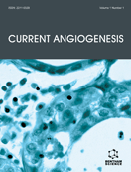Abstract
Angiogenesis is a physiological process involved in the maturation and the development of the tissues, allowing a supply of oxygen and nutrients [1]. This process is stimulated in certain pathological conditions, including carcinogenesis. Angiogenesis has long been regarded as an important target in the treatment of cancer. Much progress has been made in identifying factors involved in angiogenesis, as well as treatment options for many cancers, thanks to antiangiogenic therapies [2, 3]. So it appears that angiogenesis has significant mechanistic complexity, resistance and therapeutic exhaust now are practical limits to the development of drugs [4]. Recent studies in several experimental models suggest that both tumor and non-tumor (stromal) cell types may be involved in the reduced responsiveness to the treatments. The current review focuses on mechanisms, which result in dynamic changes occur in the tumor microenvironment in response to antiangiogenic therapy, resulting in drug resistance. These mechanisms include direct selection of clonal cell populations with the ability to rapidly upregulate other proangiogenic channels, an increased capacity for invasion and an intrinsic resistance to hypoxia [5].
Keywords: Angiogenesis, resistance mecanisms, targeted therapies.
Graphical Abstract
 9
9

